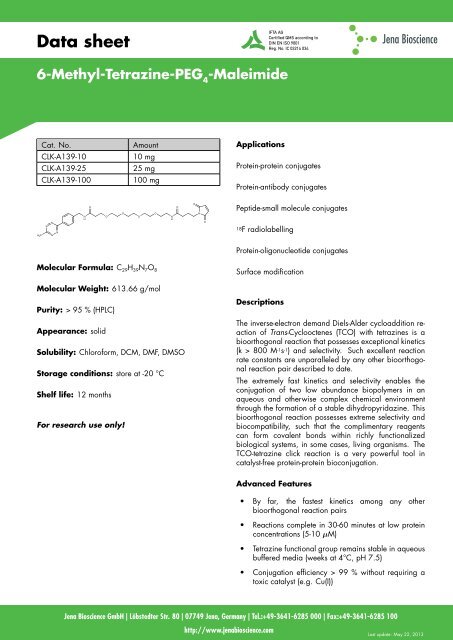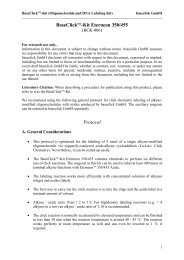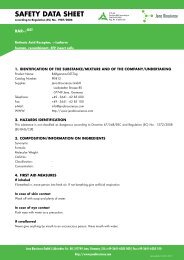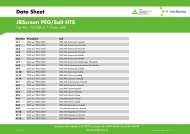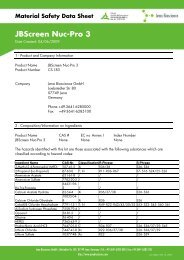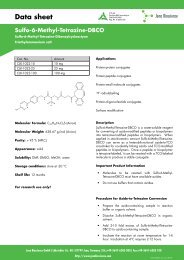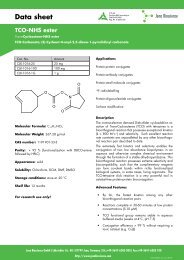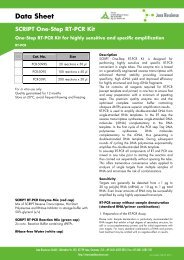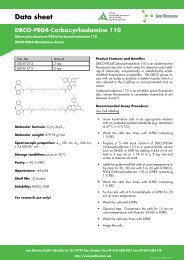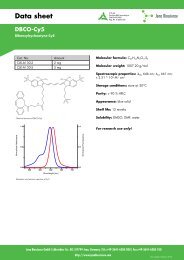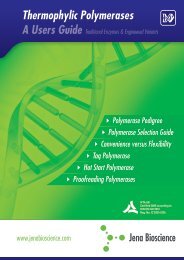Data sheet 6-Methyl-Tetrazine-PEG - Jena Bioscience
Data sheet 6-Methyl-Tetrazine-PEG - Jena Bioscience
Data sheet 6-Methyl-Tetrazine-PEG - Jena Bioscience
You also want an ePaper? Increase the reach of your titles
YUMPU automatically turns print PDFs into web optimized ePapers that Google loves.
<strong>Data</strong> <strong>sheet</strong><br />
6-<strong>Methyl</strong>-<strong>Tetrazine</strong>-<strong>PEG</strong> 4<br />
-Maleimide<br />
Cat. No.<br />
CLK-A139-10<br />
CLK-A139-25<br />
CLK-A139-100<br />
Amount<br />
10 mg<br />
25 mg<br />
100 mg<br />
Applications<br />
Protein-protein conjugates<br />
Protein-antibody conjugates<br />
H 3 C<br />
N<br />
N<br />
N<br />
N<br />
N<br />
H<br />
O<br />
O<br />
O<br />
O<br />
O<br />
N<br />
H<br />
O<br />
O<br />
N<br />
O<br />
Peptide-small molecule conjugates<br />
18F radiolabelling<br />
Protein-oligonucleotide conjugates<br />
Molecular Formula: C 29 H 39 N 7 O 8<br />
Molecular Weight: 613.66 g/mol<br />
Purity: > 95 % (HPLC)<br />
Appearance: solid<br />
Solubility: Chloroform, DCM, DMF, DMSO<br />
Storage conditions: store at -20 °C<br />
Shelf life: 12 months<br />
For research use only!<br />
Surface modification<br />
Descriptions<br />
The inverse-electron demand Diels-Alder cycloaddition reaction<br />
of Trans-Cyclooctenes (TCO) with tetrazines is a<br />
bioorthogonal reaction that possesses exceptional kinetics<br />
(k > 800 M -1 s -1 ) and selectivity. Such excellent reaction<br />
rate constants are unparalleled by any other bioorthogonal<br />
reaction pair described to date.<br />
The extremely fast kinetics and selectivity enables the<br />
conjugation of two low abundance biopolymers in an<br />
aqueous and otherwise complex chemical environment<br />
through the formation of a stable dihydropyridazine. This<br />
bioorthogonal reaction possesses extreme selectivity and<br />
biocompatibility, such that the complimentary reagents<br />
can form covalent bonds within richly functionalized<br />
biological systems, in some cases, living organisms. The<br />
TCO-tetrazine click reaction is a very powerful tool in<br />
catalyst-free protein-protein bioconjugation.<br />
Advanced Features<br />
• By far, the fastest kinetics among any other<br />
bioorthogonal reaction pairs<br />
• Reactions complete in 30-60 minutes at low protein<br />
concentrations (5-10 µM)<br />
• <strong>Tetrazine</strong> functional group remains stable in aqueous<br />
buffered media (weeks at 4°C, pH 7.5)<br />
• Conjugation efficiency > 99 % without requiring a<br />
toxic catalyst (e.g. Cu(I))<br />
<strong>Jena</strong> <strong>Bioscience</strong> GmbH | Löbstedter Str. 80 | 07749 <strong>Jena</strong>, Germany | Tel.:+49-3641-6285 000 | Fax:+49-3641-6285 100<br />
http://www.jenabioscience.com<br />
Last update: May 22, 2013
<strong>Data</strong> <strong>sheet</strong><br />
6-<strong>Methyl</strong>-<strong>Tetrazine</strong>-<strong>PEG</strong> 4<br />
-Maleimide<br />
Important Product Information<br />
• Molecules to be reacted with maleimide compounds<br />
must have free (reduced) sulfhydryls. Reduce peptide<br />
disulfide bonds with disulfide reducing reagents<br />
such as TCEP Disulfide Reducing Gel (Pierce Biotechnology).<br />
Reduce disulfide bonds in high molecular<br />
weight proteins using 5 mM TCEP (1:100 dilution)<br />
for 30 minutes at room temperature, followed by<br />
TCEP removal using a desalting column. Proteins<br />
(e.g., antibodies) can be inactivated by complete<br />
reduction of their disulfide bonds. Selective reduction<br />
of hinge-region disulfide bonds in IgG can be<br />
accomplished with 2-Mercaptoethylamine x HCl (2-<br />
MEA). Sulfhydryls can be added to molecules using<br />
N-succinimidyl S-acetylthioacetate (SATA) or 2-<br />
iminothiolane x HCl (Traut’s Reagent), which modify<br />
primary amines.<br />
• Do not use buffers that contain sulfhydryl-containing<br />
components (e.g., DTT) or azides.<br />
• Avoid buffers that contain azides.<br />
• The maleimide group reacts predominantly with free<br />
sulfhydryls at pH 6.5-7.5, forming stable thioether<br />
bonds. At pH values > 7.5, reactivity toward primary<br />
amines and hydrolysis of the maleimide groups<br />
can occur. At pH 7, the maleimide group is 1,000<br />
times more reactive toward a free sulfhydryl than to<br />
an amine.<br />
• Reactions between tetrazine and TCO are complete<br />
in 30-60 minutes at 5-10 µM.<br />
Additional Material Required<br />
• Water-miscible organic solvent such as dimethyl sulfoxide<br />
(DMSO) or dimethyl formamide (DMF)<br />
• Reaction buffer: Phosphate-buffer (100 mM sodium<br />
phosphate, 150 mM NaCl, pH 7.5) or other suitable<br />
amine-free buffer at pH 6.5-7.5. Include 5-10 mM<br />
EDTA to help prevent the reoxidation of disulfides by<br />
trace divalent metals.<br />
• Spin Desalting Colum (e.g. ThermoScientific Zeba )<br />
Procedure for Labeling Proteins<br />
• Buffer exchange proteins into phosphate reaction<br />
buffer at 1-5 mg/ml using a desalt spin column.<br />
• Immediately before use prepare 5-20 mM 6-<strong>Methyl</strong>-<br />
<strong>Tetrazine</strong>-<strong>PEG</strong> 4 -Maleimide reagent in DMSO or DMF.<br />
• Add a 20-fold molar excess maleimide reagent to<br />
the protein sample and incubate for 1 hours at room<br />
temperature or for 2 hours at 4°C.<br />
• Note: The reaction solution may appear cloudy as<br />
a result of the low aqueous solubility of 6-<strong>Methyl</strong>-<br />
<strong>Tetrazine</strong>-<strong>PEG</strong> 4 -Maleimide; usually, such solutions become<br />
clearer as the reaction proceeds. Many proteins<br />
will precipitate when the DMF or DMSO concentration<br />
exceeds 10 % of the final reaction volume;<br />
if protein solubility is not an issue, there is no limit to<br />
the DMF or DMSO concentration that may be used.<br />
• Quench reaction by adding quenching buffer at 10-<br />
50 mM final and incubating for 15 minutes at room<br />
temperature. Alternatively (or in addition) remove<br />
the excess reagent by desalting the labeled protein<br />
through a desalt spin column or by dialysis.<br />
Protein-Protein <strong>Tetrazine</strong>/TCO Conjugation<br />
• Calculate volume tetrazine-labeled protein (1-5<br />
mg/ml) equivalent to a 2-5 fold molar excess over<br />
desired volume TCO-labeled protein (1-5 mg/ml).<br />
• Mix calculated volume tetrazine-labeled protein with<br />
desired volume of TCO-labeled protein.<br />
• Allow reaction to proceed for 60 minutes at room<br />
temperature.<br />
• Store conjugate at 4°C until ready for purification or<br />
use.<br />
• Quenching buffer: concentrated (0.5-1 M) cysteine,<br />
DDT or other thiol containing reducing agents<br />
<strong>Jena</strong> <strong>Bioscience</strong> GmbH | Löbstedter Str. 80 | 07749 <strong>Jena</strong>, Germany | Tel.:+49-3641-6285 000 | Fax:+49-3641-6285 100<br />
http://www.jenabioscience.com<br />
Last update: May 22, 2013
<strong>Data</strong> <strong>sheet</strong><br />
6-<strong>Methyl</strong>-<strong>Tetrazine</strong>-<strong>PEG</strong> 4<br />
-Maleimide<br />
Troubleshooting<br />
Problem: No or poor labeling of protein with <strong>Tetrazine</strong><br />
• Possible reason: Maleimide hydrolyzed<br />
- Allow product to equilibrate to room temperature<br />
before opening<br />
• Possible reason: Thiol-contaminants in protein labeling<br />
reaction buffer (e.g. Glycine, Tris)<br />
- Buffer exchange proteins into an amine-free buffer<br />
before labeling (e.g. 100 mM sodium phosphate,<br />
150 mM sodium chloride, pH 7.5)<br />
Selected References:<br />
Devaraj et al. (2009) Fast and Sensitive Pre-Targeted Labeling of<br />
Cancer Cells through a <strong>Tetrazine</strong>/trans-Cyclooctene Cycloaddition.<br />
Angew. Chem. Int. Ed. 48:7013.<br />
Haun et al. (2009) Probing Intracellular Biomarkers and Mediators of<br />
Cell Activation Using Nanosensor and Bioorthogonal Chemistry. ACS<br />
Nano. 5:3204.<br />
Blackman et al. (2008) <strong>Tetrazine</strong> Ligation: Fast Bioconjugation Based<br />
on Inverse-Electron-Demand Diels-Alder Reactivity. J. Am. Chem. Soc.<br />
130:13518.<br />
Devaraj et al. (2008) <strong>Tetrazine</strong>-Based Cycloadditions: Application to<br />
Pretargeted Live Cell Imaging. Bioconjugate Chem. 19:2297.<br />
• Possible reason: Sub-optimal reaction conditions.<br />
- Optimize labeling conditions by altering molar excess<br />
<strong>Jena</strong> <strong>Bioscience</strong> GmbH | Löbstedter Str. 80 | 07749 <strong>Jena</strong>, Germany | Tel.:+49-3641-6285 000 | Fax:+49-3641-6285 100<br />
http://www.jenabioscience.com<br />
Last update: May 22, 2013


